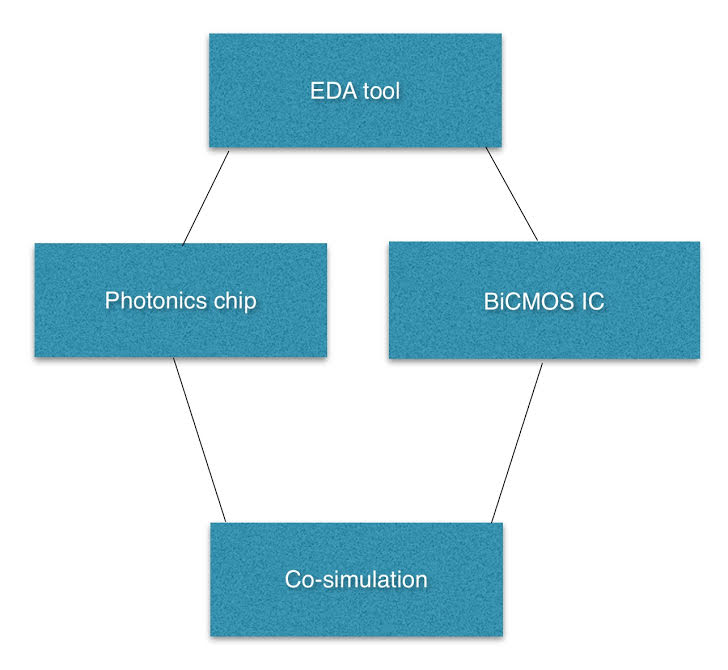Wednesday
Nov192014
STMicro chooses PSM4 for first silicon photonics product
 Wednesday, November 19, 2014 at 5:46PM
Wednesday, November 19, 2014 at 5:46PM STMicroelectronics has revealed that its first silicon photonics product will be the 100 Gigabit PSM4. The 500m-reach PSM4 multi-source agreement (MSA) is a single-mode design that uses four parallel fibres in each direction. The chip company expects the PSM4 optical engine to be in production during 2015.
"We have prototypes and can show them running very well at 40 Gig [4x10 Gig]," says Flavio Benetti, group vice president, digital product group and general manager, networking products division at STMicroelectronics. "But it is expected to be proven at 4x25 Gig in the next few months." STMicroelectronics has just received its latest prototype chip that is now working at 4x25 Gig.
Benetti is bullish about the technology's prospects: "Silicon photonics is really a great opportunity today in that, once proven, it will be a strong breakthrough in the market." He highlights three benefits silicon photonics delivers:
- Lowers the manufacturing cost of optical modules
- Improves link speeds
- Reduces power consumption
Silicon photonics provides an opportunity to optimise the supply chain, he says. The technology simplifies optical module manufacturing by reducing the number of parts needed and the assembly cost.
Regarding speed, STMicroelectronics cites its work with Finisar demonstrating a 50 Gig link using silicon photonics that was detailed at the recent ECOC show. "Photonic processing integrated into a CMOS line allows this intrinsically, while there are several factors that doesn't allow such an easy implementation of 50 Gig with traditional technologies," he says, citing VCSELs and directly-modulated lasers as examples.
"We think we can bring an advantage in the power consumption as well," says Benetti. There still needs to be ICs such as to drive the optical modulator, for example, but the optical circuitry has a very low power consumption.
STMicroelectronics licensed silicon photonics technology from Luxtera in 2012 and has a 300mm (12-inch) wafer production line in Crolles, France. The company will not offer a foundry service to other companies since STMicroelectronics believes its silicon photonics process offers it a competitive advantage.
The company has also developed its own electronic design automation tool (EDA) for silicon photonics. The EDA tool allows optical circuitry to be simulated alongside the company's high-speed BiCMOS ICs. "What we have developed covers our needs," says Benetti. "But we are working to evolve it to more complex models."
 STMicro's in-house silicon photonics EDA. "We will develop the EDA tools to the level needed for the next generation products," says Flavio Benetti.
STMicro's in-house silicon photonics EDA. "We will develop the EDA tools to the level needed for the next generation products," says Flavio Benetti.The company has developed a fibre attachment solution. "The big issue with silicon photonics is not the silicon part; it is getting the light in and out [of the chip]," says Benetti. The in-house technique is being made available to customers. "It is much more convenient for customers to attach the fibre, not us, as it is quite delicate." STMicroelectronics will deliver the optical engine and its customers will finish the design and attach the fibres.
Other techniques to couple light onto the chip are also being explored by the company. "Why should we need the fibre?" he says. "We should find a better way to get the light in and the light out." The goal of the work is to develop techniques that can be implemented on a fabrication plant scale. "The problem is [developing a technique] not to produce 100 parts but one million parts; this is the angle we are taking."
Meanwhile, the company is evaluating high-speed designs for 400 Gigabit Ethernet. "I don't see in the short-to-medium term a solution that is 400 Gig-one fibre," says Benetti. The work involves looking at the trade-offs of the various design approaches such as parallel fibres, WDM and modulation schemes like PAM-4 and PAM-8 (pulse amplitude modulation).
Performance parameters used to evaluate the various design options include cost and power consumption. But Benetti says more work is needed before STMicroelectronics will choose particular designs to pursue.



Reader Comments